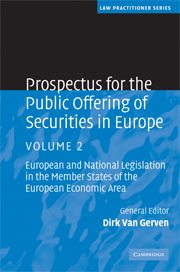 Prospectus for the Public Offering of Securities in Europe
Prospectus for the Public Offering of Securities in Europe from Part III - Application in the EEA Member States
Published online by Cambridge University Press: 06 January 2010
Introduction
14.1 Iceland implemented the Prospectus Directive by Act No. 31/2005, which amended the Act on Securities Transactions No. 33/2003. On 1 November 2007, Act No.33/2003 on Securities Transactions was replaced by a new Act on Securities Transactions No. 108/2007 (the ‘Securities Act’). The rules governing the publication of a prospectus in the event of a public offering of securities or a request for admission to trading on a regulated market were laid down in Chapter VI of the Securities Act. The aforesaid rules governing the publication of a prospectus were taken up practically unchanged in the Securities Act from the previous Act.
14.2 Following the implementation of the Prospectus Directive into Icelandic law, four new regulations on public offering of securities and request for admission to trading on a regulated market were adopted. The purpose of these regulations is to implement further the requirements set by the Prospectus Directive. The aforesaid regulations are, first, Regulation No. 242/2006 on public offerings of securities with a total value of ISK210 million or more and the admission of securities to trading on a regulated market; second, Regulation No. 243/2006 on the adoption of Commission Regulation No. 809/2004 implementing Directive 2003/71/EC of the European Parliament and of the Council as regards information contained in prospectuses as well as the format, incorporation by reference and publication of such prospectuses and dissemination of advertisements; third, Regulation No. 244/2006 on public offerings of securities with a total value of ISK8.4 million to ISK210 million; and fourth, Regulation No. 245/2006 on official admission to trading on a regulated market.
[…]
To save this book to your Kindle, first ensure [email protected] is added to your Approved Personal Document E-mail List under your Personal Document Settings on the Manage Your Content and Devices page of your Amazon account. Then enter the ‘name’ part of your Kindle email address below. Find out more about saving to your Kindle.
Note you can select to save to either the @free.kindle.com or @kindle.com variations. ‘@free.kindle.com’ emails are free but can only be saved to your device when it is connected to wi-fi. ‘@kindle.com’ emails can be delivered even when you are not connected to wi-fi, but note that service fees apply.
Find out more about the Kindle Personal Document Service.
To save content items to your account, please confirm that you agree to abide by our usage policies. If this is the first time you use this feature, you will be asked to authorise Cambridge Core to connect with your account. Find out more about saving content to Dropbox.
To save content items to your account, please confirm that you agree to abide by our usage policies. If this is the first time you use this feature, you will be asked to authorise Cambridge Core to connect with your account. Find out more about saving content to Google Drive.